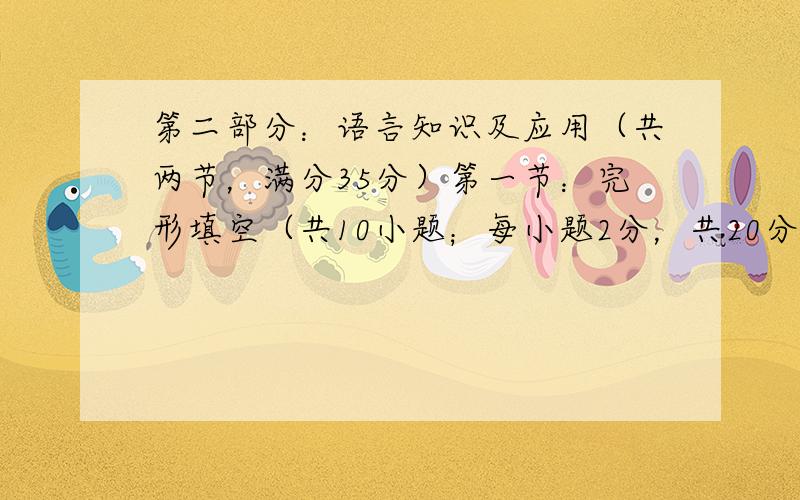第二部分:语言知识及应用(共两节,满分35分)第一节:完形填空(共10小题;每小题2分,共20分) 阅读下面短文,掌握其
来源:学生作业帮 编辑:神马作文网作业帮 分类:英语作业 时间:2024/11/06 12:34:54
| 第二部分:语言知识及应用(共两节,满分35分) 第一节:完形填空(共10小题;每小题2分,共20分) 阅读下面短文,掌握其大意,然后从21~35各题所给的四个选项(A、B、C和D)中,选出最佳选项,并在答题卷上将其该项涂黑。 “Long time no see” is a very interesting sentence. When I first read this sentence from an American friend’s email, I laughed. I thought it was a perfect 21 of Chinglish. Obviously, it is a word-by-word literal(照字面意思的) translation of the Chinese greeting with a ruined English grammar and structure! Later on, my friend told me that it is a standard American 22 . I was too amazed to believe her. Her words could not convince me 23 . So I did a search on www.google.com. To my surprise, there are over 60 thousand web pages 24 “long time no see”. This sentence has been 25 used in emails, letters, newspapers, movies, books, or any other possible place. Though it is sort of informal, it is part of the language that Americans use daily. 26 , if you type this phrase in Microsoft Word, the software will tell you that the grammar needs to be corrected. Nobody knows the 27 of this Chinglish sentence. Some people believe that it came from Charlie Chan’s movies. In the 1930s, Hollywood moviemakers successfully 28 a world wide famous Chinese detective named “Charlie Chan” on wide screens. Detective Chan liked to teach Americans some Chinese wisdom by quoting(引用) Confucius(孔子). “Long time no see” was his trademark. Soon after Charlie Chan, “Long time no see” became a popular phrase in the real world thanks to the popularity of these movies. Some scholars compare America to a huge pot of stew(大熔炉). All kinds of culture are mixed in the stew together, and they 29 the color and taste of each other. American Chinese, though a minority ethnic(少数民族的) group in the United States, is also influenced some changes to the stew! Language is usually the first thing to be 30 in the mixed stew. 21. A. word B. sign C. example D. change 22. A. custom B. greeting C. habit D. proverb 23. A. almost B. in all C. at all D. after all 24. A. publishing B. printing C. containing D. expressing 25. A. seldom B. hardly C. widely D. deeply 26. A.Unfortunately B. Luckily C. Suddenly D. However 27. A. use B meaning C .expression D. origin 28. A. did B. published C. created D. discovered 29. A. improve B. change C. lower D. promote 30. A. mentioned B. used C. considered D. influenced |

21—25 CBCCC 26—30 DDCBD
略
第二部分:语言知识及应用(共两节,满分35分)第一节:完形填空(共10小题;每小题2分,满分20分)阅读下面短文,掌握其
第二部分语言知识及应用(共两节, 满分35分)第一节:完形填空(共10小题,每小题2分,满分20分)阅读下面短文,掌握其
第二部分:语言知识与应用(共两节,满分25分)第一节:完型填空(共10小题,每小题1分,共10分)阅读下面短文,掌握其大
Ⅱ 语言知识及应用 (共两节。满分35分)第一节完形填空 (共10小题;每小题2分,满分20分)阅读下面短文,掌握其大意
Ⅱ 语言知识及应用 (共两节,满分35分) 第一节完形填空 (共10小题;每小题2分,满分20分) 阅读下面短文,掌握其
.II.语言知识及应用(共两节,满分35分)第一节:完形填空(共10小题;每小题2分,满分20分)阅读下面短文,掌握其大
第二部分语言知识及应用(共两节, 满分37.5分)第一节:完形填空(共10小题,每小题2分,满分20分)阅读下面短文,掌
第二部分:语言知识与运用(共两节,满分45分)第一节:完形填空(共15小题;每小题2分,满分30分)阅读下面短文,掌握其
第二部分 语言知识及应用(共两节,满分35分)第一节 完形填空(共10小题;每小题2分,满分20分)
语言知识及应用(共两节,满分45分)第一节完形填空(共15小题;每小题2分.满分30分)阅读下面短文,掌握其大意.然后从
II.语言知识及应用(共两节, 满分35分)第一节:单项填空(共15小题,每小题1分,满分15分)阅读下面短文,掌握其大
第二部分:语言知识及应用(共两节,满分35分)第一节 完形填空(共10小题;每小题2分,满分20分)阅读下面短